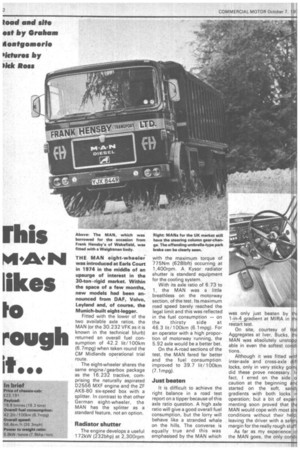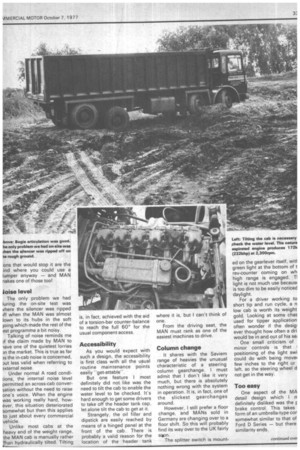rhis
Page 34

Page 35

Page 37

If you've noticed an error in this article please click here to report it so we can fix it.
kol•AeN1
likes
I.
rough
it...
in brief
THE MAN eight-wheeler: was introduced at Earls Court in 1974 in the middle of an upsurge of interest in the 30-ton-rigid market. Within the space of a few months, new models had been announced from OAF. Volvo, Leyland and, of course, the Munich-built eight-legger.
Fitted with the lower of the two available axle ratios, the MAN (or the 30.232 VFK as it is known in the technical blurb) returned an overall fuel consumption of 42.2 lit/100km (6.7mpg) when taken round the CM Midlands operational trial route.
The eight-wheeler shares the same engine/gearbox package as the 1 6.232 tractive, comprising the naturally aspirated D2556 MXF engine and the ZF .AK6-80 six-speed box with a splitter. In contrast to that other German eight-wheeler, the MAN has the splitter as a standard feature, not an option.
Radiator shutter
The engine develops a useful 172kW (232bhp) at 2,300rpm with the maximum torque of 775Nm (628Ibft) occurring at 1,400rprn. A Kysor radiator shutter is standard equipment for the cooling system.
With its axle ratio of 6.73 to 1, the MAN was a little breathless on the motorway section, of the test. Its maximum road speed barely reached the legal limit and this was reflected in the fuel consumption — on the thirsty side at 46.3 lit/100km (6.1mpg). For an operator with a high proportion of motorway running, the 5.92 axle would be a better bet.
On the A-road sections of the test, the MAN fared far better and the fuel consumption improved to 39.7 lit/100km (7.1mpg).
Just beaten
It is difficult to achieve the right balance in a road test report on a tipper because of this axle ratio question. A high axle ratio will give a good overall fuel consumption, but the lorry will behave like a stranded whale on the hills. The converse is equally true and this was emphasised by the MAN which was only just beaten by tht 1-in-4 gradient at MIRA in th( restart test.
On site, courtesy of Hal Aggregates at lver, Bucks, th( MAN was absolutely unstopp able in even the softest condi tions.
Although it was fitted with inter-axle and cross-axle difl locks, only in very sticky goinc did these prove necessary. Ir fact, I erred on the side cr caution at the beginning anc started on the soft, sand) gradients with both locks ir operation; but a bit of experi. menting soon proved that thE MAN would cope with most Sit( conditions without their help, leaving the driver with a safety margin for the really rough stuff
As far as my experience ol the MAN goes, the only condi. ons that would stop it are the ind where you could use a lumper anyway — and MAN nakes one of those too!
foise level
The only problem we had luring the on-site test was vhere the silencer was ripped iff when the MAN was almost lown to its hubs in the soft joing which made the rest of the est programme a bit noisy.
Talking of noise reminds me )f the claim made by MAN to lave one of the quietest lorries an the market. This is true as far as the in-cab noise is concerned, aut less valid when referring to 3xternal noise.
Under normal A road conditions, the internal noise level permitted an across-cab conversation without the need to raise one's voice. When the engine was working really hard, however, this situation deteriorated somewhat but then this applies to just about every commercial vehicle.
Unlike most cabs at the heavy end of the weight range, the MAN cab is manually rather than hydraulically tilted. Tilting
is, in fact, achieved with the aid of a torsion-bar counter-balance to reach the full 600 for the usual component access.
Accessibility
As you would expect with such a design, the accessibility is first class with all the usual routine maintenance points easily "get-attable''.
But one feature I most definitely did not like was the need to tilt the cab to enable the water level to be checked. It's hard enough to get some drivers to take off the header tank cap, let alone tilt the cab to get at it.
Strangely, the oil filler and dipstick are easily reached by means of a hinged panel at the front of the cab. There is probably a valid reason for the location of the header tank where it is, but I can't think of one.
From the driving seat, the MAN must rank as one of the easiest machines to drive.
Column change
It shares with the Saviem range of heavies the unusual characteristic of a steering column gearchange. I must admit that I don't like it very much, but there is absolutely nothing wrong with the system in operation. It is, in fact, one of the slickest gearchanges around.
However, I still prefer a floor change, and MANs sold in Germany are changing over to a floor shift. So this will probably find its way over to the UK fairly soion.
The splitter switch is mount ed on the gearlever itself, witt green light at the bottom of t rev-counter coming on wh high range is engaged. TI light is not much use becausf is too dim to be easily noticed daylight.
For a driver working to short tip and run cycle, a n low cab is worth its weight gold. Looking at some chas used for tipper application often wonder if the desigi ever thought how often a dri would be in and out of his sei One small criticism of minor controls is that 1 positioning of the light swi could do with being movei few inches to the right or left, so the steering wheel d not get in the way.
Too easy
One aspect of the MA detail design which I rr definitely disliked was the r brake control. This takes form of an umbrella-type cor somewhat similar to that of Ford D Series — but there similarity ends. I found that this control ( the MAN was far too easy release accidentally — it can I flicked with the little finger, 1 little effort is required. In n opinion, some sort of dete is necessary to prevent the pa brakes being released accider ally.
Braking performance
Most eight-wheelers have total brake lining frictional ar of around 11,500 sqc (1,780sqin), but the shares with the Foden t characteristic of a relativi small lining area at 8,300sqi (1,286sqin). Not that this mE any difference to the stoppi power with consistent averE decelerations of just under 0. being achieved.
On the dry road surface of MIRA number two circuit, MAN pulled up in a straight I with slight wheel locking justhe last minute. Eight-wheel are always very well-balani machines during full press braking stops and the Mun machine confirmed this opin with a stopping distance fractionally over 11 Oft from initial road speed of 40mph.
It's all very well quot stopping distance achieved MIRA, but how the bra behave under normal cor tions is just as important.
, Here, I had complete co dence in the MAN. The bra had a very progressive about them too — a us characteristic in heavy traffic least you don't make machine stand on its nose eN time you so much as breath( the pedal.
As far as the exhaust bi was concerned, the story is good. Many lorries have in cient exhaust brakes and MAN was one of them. Eve high engine revs, the bra! effect was barely noticeable an undesirable side-effect the black puff of smoke fronexhaust when the button released.
Summary
As an on-site machine MAN was first class with ability to haul itself out of situation.
The overall fuel consump was rather spoilt by the mc way result but, for opera with a high proportion highway work, the higher ratio of 5.92 is available.
German vehicles tend t( on the expensive side in thE due to the currency differ( and the MAN is no exceF carrying a chassis cab pricE of £23,191.












































































































